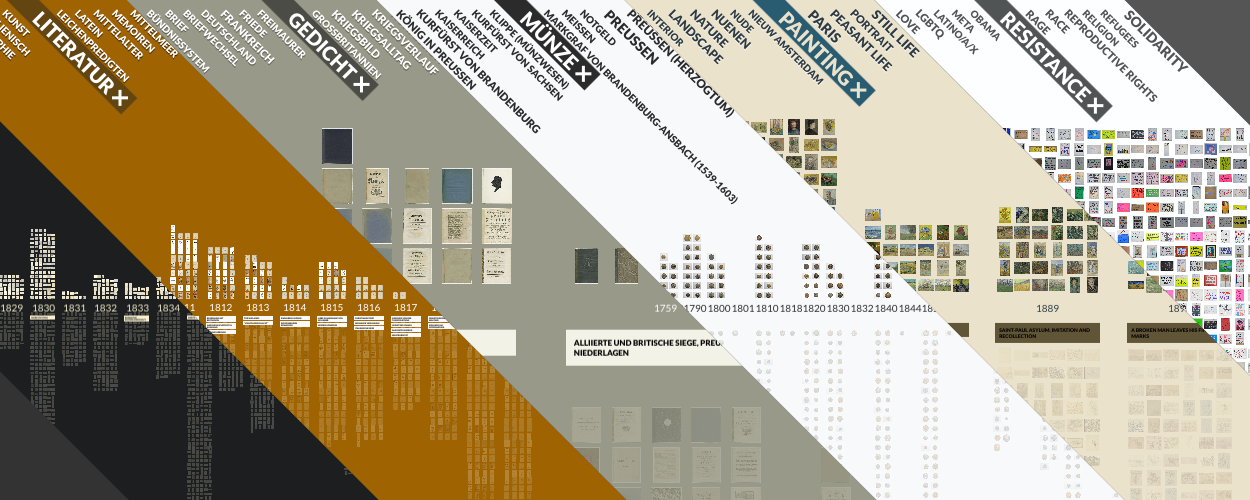VIKUS Viewer is an advanced web-based visualization system that arranges thousands of cultural artifacts on a dynamic canvas and supports the exploration of thematic and temporal patterns of large collections, while providing rapid access to high-resolution imagery.

Cultural collections feature three fundamental facets that are essential to make sense of their contents: time, themes, and texture. The time an artifact was created provides essential context to make sense of the themes it depicts and its visual texture. The VIKUS Viewer offers an interactive environment to explore a wide range of cultural collections along these three aspects.
The images are positioned on a canvas according to their historical dating and are further contextualized by historical events. The zoomable canvas allows the viewer to see the collection as a whole in the form of a histogram comprised of the very items in the collection. Zooming into individual images reveals high-resolution details such as paint artifacts, traces of use, and fine-grained texture of the paper. The keywords associated with collection items are displayed at the top of the interface in an interactive list that indicates the frequency of themes in the collection and allows for flexible filtering. Keyword selections reveal the rich relationships among the themes of a collection.
At the moment, there are six running instances:
– 1506 coins of Brandenburg-Prussian origin (16th to 19th century)
– 3273 books in Johann Wolfgang von Goethe’s library (1749–1832)
– 212 multi-page pamphlets from the Seven Years’ War (1756–1763)
– 6905 drawings by Frederick William IV (1795–1861)
– 986 drawings and paintings by Vincent van Gogh (1853–90)
– 5949 protest signs of the Boston Women’s March (21 Jan 2017)
VIKUS Viewer is based on the code behind Past Visions, a collaborative effort by Katrin Glinka, Christopher Pietsch, and Marian Dörk carried out in the context of the VIKUS project (2014-2017). The software was designed and developed by Christopher Pietsch and is available under an open source license on GitHub.
If you are interested in using it or have any questions, feel free to contact us.
This project was carried out in cooperation with the Prussian Palaces and Gardens Foundation (SPSG), the Research Center Sanssouci (RECS), and Forschungsverbund Marbach Weimar Wolfenbüttel (MWW).
Publications
Associated Publications
—
in: Konferenzband zur DHd 2017 Bern - Digitale Nachhaltigkeit,
2017
Die Entwicklung digitaler Werkzeuge lässt sich als wichtiger Teilbereich in den Digital Humanities identifizieren (Davis und Kräutli 2015; Schnapp et al. 2009). Entsprechende Forschung und Projektarbeit steht dabei komplexen Herausforderungen gegenüber. Nicht nur die Frage nach verfügbaren Daten, methodologischer Fundierung und technologischer Umsetzbarkeit, sondern auch die Frage nach deren langfristigen Verfügbarmachung sind wiederkehrende Themen der letzten Jahre. Eine zentrale Rolle für die Sicherstellung von Qualität und Anwendbarkeit der digitalen Werkzeuge ist die Einbindung von Forscher_innen der jeweiligen geisteswissenschaftlichen Disziplinen im Entwicklungsprozess (Drucker 2013). Gleichzeitig lässt sich die zentrale Bedeutung von Interfacedesign, Nutzungsanleitungen und Benutzerfreundlichkeit als wichtige Faktoren für die Etablierung von digitalen Werkzeugen im Forschungsprozess feststellen (Gibbs und Owens 2012). Doch selbst wenn diese Herausforderungen bewältigt werden und ein digitales Werkzeug (erfolgreich) entwickelt wurde, stellt sich weiterhin die Frage, wie die langfristige Nachnutzung im Sinne einer digitalen Nachhaltigkeit sichergestellt werden kann. Am Beispiel des Entstehungsprozesses einer sammlungsspezifischen Visualisierung und deren Weiterentwicklung zu einem nachnutzbaren Werkzeug werden einige zentrale Aspekte der beeinflussenden Faktoren und Lösungsansätze vorgestellt. Unser Beitrag stellt sich somit der Frage, wie sichergestellt werden kann, dass digitale Tools auch über die Laufzeit von Förderprojekten hinaus (und unabhängig von spezifischen Use-cases) dauerhaft nutzbar und weiterentwickelbar sind.
Expand
—
DHQ: Digital Humanities Quarterly. 11:2,
2017
We present a case study on visualizing a collection of historic drawings along its metadata structure while also allowing for close examination of the artifacts’ texture. With regards to the specific character of cultural heritage at the intersection of research, education, and public interest, the presented visualization environment aims at meeting the requirements of both researchers as well as a broader public. We present the results from a collaborative interdisciplinary research project that involved a cultural heritage foundation, art historians, designers, and computer scientists. The case study examines the potential of visualization when applied to, and developed for, cultural heritage collections. It specifically explores how techniques aimed at visualizing the quantitative structure of a collection can be coupled with a more qualitative mode that allows for detailed examination of the artifacts and their contexts by displaying high-resolution views of digitized cultural objects with detailed art historical research findings. Making use of latest web technologies, the resulting visualization environment allows for dynamic filtering and zooming of a collection of visual resources that are arranged along a contextualized timeline. We share insights from our collaborative design process and the feedback and usage data gathered during the deployment of the resulting prototype as a web application. We end with a discussion of transferability of carefully crafted and collaboratively negotiated visualizations of cultural heritage and raise questions concerning the applicability of our approach to related strands of humanities research.

